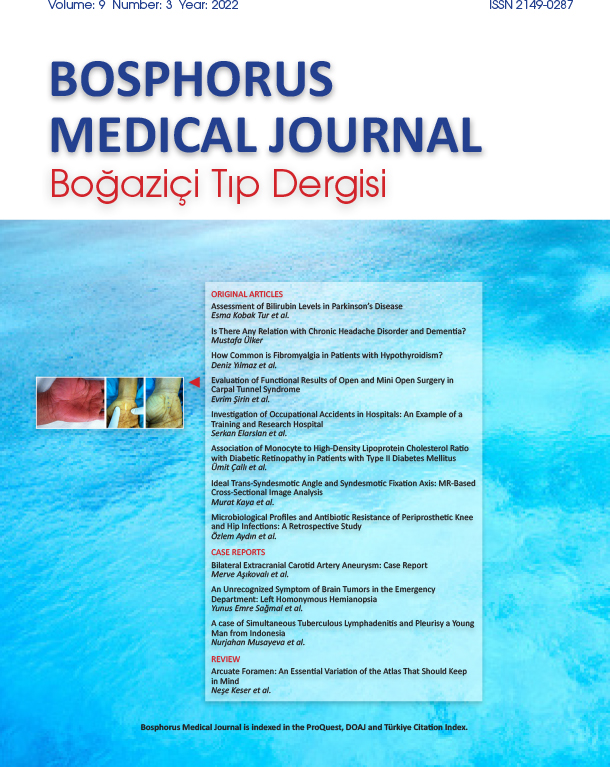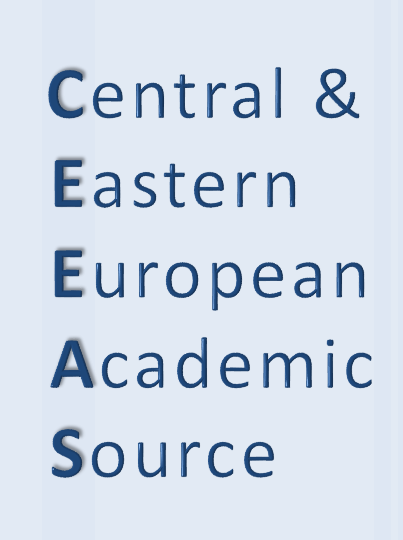Volume: 8 Issue: 1 - 2021
| FRONT MATTERS | |
| 1. | Frontmatters Pages I - VII |
| ORIGINAL RESEARCH | |
| 2. | Comparison of Intrarectal Lidocainated Gel, Intrarectal Ultrasonic Gel and Periprostatic Nerve Blockage concerning Patients Pain Tolerance Gökhan Çevik, Mustafa Ozan Ataçer, Hakan Akdere, Ersan Arda, Tevfik Aktoz doi: 10.14744/bmj.2020.77699 Pages 1 - 6 INTRODUCTION: Prostate biopsy is the gold standard method used in the diagnosis of prostate cancer. While periprostatic injection of local anesthetic agents during this procedure is the most effective method for reducing pain during the prostate biopsy, there are studies indicating that application of a local anesthetic agent to the rectum is also an effective method. In this study, we compared the effectiveness of intrarectal lidocaine gel (Konix Catheter Gel®), intrarectal ultrasonic gel (Konix Ultrasonic Gel®) and lidocaine administered to the periprostatic region in pain reduction before taking prostate biopsy in our patients with prostate biopsy indication. METHODS: In our study, 100 volunteer patients with prostate biopsy indication were included with TUTF_BAEK2019/203 approval number of Trakya University Faculty of Medicine Ethics Committee. These patients were randomly divided into four groups of 25. Groups were named A, B, C and D. A standard 12-piece prostate biopsy was performed with a tru-cut biopsy needle from all patients. After the procedure, the patient's pain tolerance was evaluated by a different individual. The VAS scale was used to assess pain tolerance. RESULTS: A statistically significant difference was also found between the groups regarding the visual pain scores in all three stages. When STAI-I of the patients participating in this study was compared, there was no significant difference among the four groups. In our study, no significant relationship was found between pre-procedure anxiety and pain during and after the procedure. DISCUSSION AND CONCLUSION: During prostate biopsies, only periprostatic blockade with lidocaine was not sufficient at the time of introduction of the probe, causing patients to feel pain, therefore, combined with periprostatic blockage with intrarectal lidocaine gel, it has been shown that it increases patient comfort and has the lowest VAS scores in all three stages of biopsy. |
| 3. | Management of the Orthopedic Fractures in the COVID-19 Pandemic Ahmet Onur Akpolat, Mehmet Emin Çelebi, Onur Gultekin, Semih Ak, Barış Yılmaz, Bekir Eray Kılınç doi: 10.14744/bmj.2020.92905 Pages 7 - 12 INTRODUCTION: To report our multidisciplinary approach to the orthopedic fracture with increasing COVID-19 diagnoses by comparing the cases within two months before and after COVID -19 pandemic in our hospital. METHODS: Fracture cases admitted to our emergency department and consulted to the orthopedic clinic were included in this study two months before pandemic (Group 1) and after the first (Group 2) two months. The number of cases, types of fractures, duration of hospitalization, waiting times for surgery and post-surgery discharge times were compared between the two groups. Approach to fracture, operating room usage and equipment selection were compiled after the pandemic. The number of cases with COVID-19 positive infection detected by PCR was recorded. Data were compared. RESULTS: The number of patients included in our study was 388. Patients were divided as Group 1 for two months before Pandemic and Group 2 for two months after. 292 (75.3%) patients were included in Group 1 and 96 (24.7%) patients were included in Group 2. Of the patients being operated, 102 (75%) were Group 1, 34 (25%) were Group 2. The duration of hospitalization was 9.54±4.28 days in Group 1 and 7.82±3.64 days in Group 2. The waiting time for surgery was 7.28±3.79 days in Group 1 and 7.23±4.37 days in Group 2. The discharge times were 3.02±1.75 days in Group 1 and 2.62±1.54 days in Group 2. There was no statistically significant difference between the groups in all evaluated parameters (p=0.14), (p=0.97) (p=0.42). DISCUSSION AND CONCLUSION: Our approach to fracture cases should be applied more rationally, optimally and rapidly within the principles of orthopedics. We must strictly follow the precautions to protect against COVID-19 infection. |
| 4. | Uncooled Microwave Ablation Method for Thyroid Nodules: Our Short-Term Results Gülşah Yıldırım, Hakkı Muammer Karakaş, Ahmet Günkan doi: 10.14744/bmj.2020.62681 Pages 13 - 20 INTRODUCTION: Treatment of benign thyroid nodules may be performed due to compressive symptoms, cosmetic problems, malignant transformation risk, and/or anxiety. In recent years, minimally invasive percutaneous ablation methods have been increasingly used instead of surgical treatment. Microwave ablation (MWA) is the new approach for thermal ablation of thyroid nodules, although data on uncooled MWA are rather limited. This study aims to investigate the safety and short-term effectiveness of percutaneous uncooled MWA in the treatment of benign thyroid nodules. METHODS: This study included nine benign thyroid nodules diagnosed with biopsy between January-March 2020. The largest diameter, volume, and composition of the nodules were evaluated before the procedure and at a 3-month follow-up. Uncooled MWA system (TATO, Terumo) with an 18G probe was used for the procedure. Thyroid function monitorization (TSH, sT4, sT3) and antibody tests (anti-TG, anti-TPO), clinical compressive symptoms and cosmetic scores were evaluated before the procedure and at 3-month follow up. Volume reduction rates were also evaluated at 3-month follow-up. RESULTS: Five solid and four mostly solid nodules were treated. The mean largest diameter was 41.64±11.41 mm and mean volume was 20.93±14.82 cm3 before the procedure, while the mean largest diameter was 28.6±5.97 mm (p=0.011) and mean volume was 8.19±3.30 cm3 (p=0.015) at 3-month follow-up. The volume reduction rate at three months was 50.20%±39.58%. Before the procedure, the median cosmetic score was 4 and the symptom score was 6; at 3-month follow-up, these scores were 2 and 1, respectively. There was no significant change in thyroid function tests and antibody levels at follow-up. Major complications were not observed. DISCUSSION AND CONCLUSION: Uncooled MWA system using 18G probe was found to be a safe and effective method in the treatment of benign thyroid nodules. With its advantages of rapidly improving clinical symptomatology and cosmetic complaints without requiring hospitalization, it has the potential to be more preferred than surgery by patients. |
| 5. | The Effect of Rigid Gas Permeable Contact Lenses on Visual Quality and Corneal Aberrations in The Keratoconus Patients Tuğba Gençağa Atakan, Sevda Aydın Kurna, Yelda Buyru Bozkurt, Tayfun Şahin, Mehmet Atakan doi: 10.14744/bmj.2020.58661 Pages 21 - 28 INTRODUCTION: Aim was to investigate the effects of rigid gas permeable contact lenses (RGPCL) on visual quality and corneal aberrations in the patients with keratoconus and myopia. METHODS: Thirty-one eyes of 17 patients wearing RGPCL because of myopia (Group A) and 72 eyes of 47 patients who had keratoconus (Group B) were included in this study. Keratoconus patients were divided into four subgroups according to the Amsler-Krumeich classification. All patients underwent examination procedures, including visual acuity, contrast sensitivity and simulated keratometric value (sim K), surface asymmetric index (SAI), surface regularity index (SRI), predicted visual acuity (PVA) values measured with corneal topography; mean RMS values of spherical aberration, coma, trefoil, and total high order aberrations (THOA) measured with aberrometry, before and after RGPCL application. RESULTS: Mean best-corrected visual acuity values before lens use was 0.68 (±0.33) and afterwards 0.86 (±0.20) in Group A, 0.37 (±0.21) and 0.83 (±0.17) in Group B, respectively. During low contrast sensitivity measurement, nine letters were gained after wearing contact lenses in Group A, 18.7 letters in Group B. The change of topographic values after contact lens use was significant in both groups. The amount of change was more significant in Group B when compared to Group A (p<0.05). There was a significant difference in PVA values between Group B1 and Group B4 (p<0.01). After contact lens use, the change in spherical, coma, trefoil and THOA values were statistically significant in both groups. The mean decrease in aberration values was significantly higher in Group B comparing to Group A (p<0.05). The aberration values except THOA did not differ significantly among subgroups. DISCUSSION AND CONCLUSION: The topographic and aberrometry values decreased significantly in all eyes after RGPCL. The amount of decrease was significantly higher in keratoconus patients. Increase in visual acuity and contrast sensitivity was correlated with the decrease in higher aberrations, which points to the close relationship between them. |
| 6. | Evaluation of The Anatomical and Visual Outcomes of Aflibercept Treatment in Patients with Diabetic Macula Edema Gökhan Demir, Gizem Kutlutürk doi: 10.14744/bmj.2020.81994 Pages 29 - 34 INTRODUCTION: To evaluate the anatomical and visual results of aflibercept treatment in patients with diabetic macular edema and how ellipsoid zone defect (EZD) and serous retinal detachment (SRD) affect the treatment outcomes. METHODS: We analyzed the medical enrollments of treatment naïve DME patients who were initially treated with aflibercept and who were completed 3 loading doses between January 2016 and January 2017 in this retrospective study. Patients having macular ischemia, peripheral retinal ischemia in fluorescein angiography, patients with vitreoretinal interface disease on spectral domain optical coherence tomography (SD-OCT), patients with DME who had received any previous treatment, or with neovascularization of retinal at beginning treatment, or patients with a follow-up of less than 12 months were excluded from the study. The patients' age, gender, best corrected visual acuity (BCVA) and central macular thickness (CMT) at baseline, 3, 6, 9 and 12 months, EZD and SRD were recorded. RESULTS: Seventy-two eyes of 47 patients including 20 women and 27 men were included in the study. The mean age of the patients was 59.7±8.0. The mean follow-up period was 14±2 months. The mean BCVA at 3, 6, 9 and 12 months was statistically better than baseline in all patient group (p<0.009, p<0.001, p<0.001 and p<0.001, respectively). Before intravitreal aflibercept, the mean BCVA was significantly better in the group without EZD than in the group with EZD. In addition, the mean BCVA was better in the group without EZD at 12 months. When we looked at the change in the mean BCVA in SRD+ and SRD- groups, the change in the mean BCVA at 3 months was similar between two groups; however, the change in the mean BCVA at 6, 9 and 12 months was higher in the group with SRD+. In all patient groups, mean central retinal thickness (CMT) was found to be significantly lower than baseline values at 3, 6, 9 and 12 months after IVA. There was a negative correlation (p<0.001) between the presence of SRD and EZD and the initial BCVA, and a positive correlation (p<0.001) between the presence of SRD at the beginning and the change in BCVA and CMT. DISCUSSION AND CONCLUSION: Aflibercept treatment is an effective and safe treatment agent for both improving BCVA and decreasing CMT in DME patients. It is effective in DME with or without SRD. EZD has a predictive value in terms of visual results of treatment. |
| 7. | Evaluation of the Optic Nerve Head Parameters with Heidelberg Retinal Tomography and the Retinal Nerve Fibers with Optical Coherence Tomography in Preperimetric Glaucoma Haşim Uslu, Nevbahar Tamçelik doi: 10.14744/bmj.2020.06078 Pages 35 - 40 INTRODUCTION: To evaluate the optic nerve head topographic (ONH) parameters obtained by Heidelberg Retinal Tomography (HRT) and retinal nerve fiber layer (RNFL) thickness measured by Optical Coherence Tomography (OCT) in preperimetric glaucoma (PPG). METHODS: Thirty eyes of 17 patients with PPG and 30 eyes of 18 healthy individuals of the same age and gender were included in this study. RNFL thickness measurements with OCT, ONH analysis with HRT and VF tests were performed in all cases. PPG inclusion criteria were defined as: intraocular pressure (IOP)> 21 mmHg in two or more measurements, 30-2 VF test normal, clinically abnormal ONH appearance (neuroretinal rim appearance with rim notching, localized or diffuse RNFL, vertical enlargement, ONH hemorrhage). RESULTS: The mean age in the PPG and the control group was 50.57±11.50 and 45.60±12.87 years, respectively. Among the PPG and control group HRT measurements, cup/disc rate (C/D), rim area (RA), maximum cup depth (MCD) and cup shape measure (CSM) parameters were significantly different; others did not show any difference (p<0.05). The inferior, superior, nasal, temporal quadrant and average thickness measurement values of RNFL thickness measured by OCT were thinner in cases with PPG than in the control group, and the difference was statistically significant (p<0.05). DISCUSSION AND CONCLUSION: This study shows that there are significant differences between PPG and normal eyes. We consider that evaluation of the ONH by HRT and measurements of the RNFL thickness by OCT may be helpful for early diagnosis in cases with PPG. |
| 8. | The Effects of Formalin Solution on Wall Thickness and Size in Stomach Resection Materials Hüseyin Çiyiltepe, Anıl Ergin, Adnan Somay, Nuriye Esen Bulut, Mehmet Mahir Fersahoğlu, Mehmet Köroğlu, Aziz Bora Karip, Ümit Akyüz, Kemal Memişoğlu doi: 10.14744/bmj.2021.94695 Pages 41 - 46 INTRODUCTION: Histopathological evaluation of endoscopic submucosal dissection (ESD)/endoscopic full-thickness resection (EFTR) resection materials is important for disease follow-up. There are many studies on the effects of formalin solution on histopathological examination. To our knowledge, in this study, the effects of this solution on the macroscopic dimensions of gastric tissue were investigated for the first time. METHODS: ESD/EFTR specimens were obtained from different localizations of the stomach resection materials removed from patients who underwent laparoscopic sleeve gastrectomy surgery due to morbid obesity. Pre- and post-formalin fixation, macroscopic measurements were made by the surgeon and pathologist conducting the study and compared with each other. RESULTS: In this study, stomach specimens taken from 50 patients with a mean age of 36.04, and a body mass index of 46.06 were evaluated. After formalin fixation, it was observed that 4.4, 5.6 and 7.2 times thickening occurred in full-layer wall thicknesses of the antrum, corpus and fundus, respectively. Similarly, 1.8, 2.5 and 4.6 times increase was found in mucosa/submucosa thickness. In addition, due to the shrinkage effect of the formalin solution, an average size reduction of 31.0% and 23.3% in the mucosa/submucosa and full-thickness stomach tissue, respectively, were detected. DISCUSSION AND CONCLUSION: The shrinkage effect of formalin solution on tissues has been reported before, but it has not provided any evidence of how this effect affects macroscopic measurements. This study is important in that, to our knowledge, it is the first study of formalin fixation to investigate macroscopic size changes on stomach tissue. |
| CASE REPORT | |
| 9. | A Case of Anti-NMDA Receptor Encephalitis with Full Recovery Irmak Salt, Pelin Doğan Ak, Işıl Kalyoncu Aslan, Çisil İrem Özgenç Biçer, Eren Gözke doi: 10.14744/bmj.2020.95867 Pages 47 - 49 Anti N-methyl-D-aspartate (NMDA) receptor antibody encephalitis is the most common autoimmune encephalitis. However, when compared to the prevalences of other neuropsychiatric diseases, it is a rare condition. Since it may present with a wide range of symptoms from depression to drug-resistant seizures, it must be considered in a differential diagnosis. It should be kept in mind that anti NMDA encephalitis usually affects young women with malignant tumors, especially over tumors. We want to present this encephalitis case which presented with psychosis and catatonia, both in terms of the patients demographical aspects and accomplishment of a full recovery. |
| 10. | An Unusual Midfoot Fracture-Dislocation: Total Dorsal Dislocation of Midfoot at the Cunei-Navicular Joint Associated with Cuboid Fracture: A Case Report Mehmet Salih Söylemez, Suat Batar doi: 10.14744/bmj.2020.29494 Pages 50 - 53 Midfoot fracture-dislocations including those involving the Chopart and Lisfranc joints can be very easy to misdiagnosed. Moreover, some rarely seen types of injuris of these region including; dorsal dislocation of the midfoot at the cunei-navicular and calcaneocuboid joints, isolated dorsal dislocation of the tarsal navicular, dorsal fracture-dislocation of the tarsal navicular and complete medial dislocation of the first cuneiform have been reported. There is a lack of obvious radiographic findings in up to 33% of such injuries and there may not be familiarity with such injuries by many treating physicians. CT scans are static imaging modalities and obtained without weight bearing. However, 3D CT scan may aid to better visualize complex fracture patterns. In this paper we report a case with a total dorsal dislocation of midfoot at the cunei-navicular joint associated with cuboid fracture diagnosed after performing a 3D CT. |
| REVIEW | |
| 11. | The Relation Between L-Carnitine Metabolism and Nutritional Therapy Deran Dalbudak Sansar, Burcu Yavunç Yeşilkaya doi: 10.14744/bmj.2020.21043 Pages 54 - 62 L-carnitine is a molecule involved in transporting long-chain fatty acids to the mitochondrial matrix and has important roles in lipid metabolism. It also has antioxidant properties. They prevent the excretion of compound components, such as propionic acid, as acyl-l-carnitine esters from accumulating in the mitochondria. While 75% of the L-carnitine is supplied by food, 25% can be renewed by endogenous biosynthesis. It is not essential for adults as it is synthesized in the body. L-carnitine, a branched-chain non-essential amino acid, is synthesized in others from the essential amino acids lysine and methionine. The richest sources of L-carnitine administered exogenously through the diet are red meat, fish, chicken and dairy products. In this review, studies on the relationship of L-carnitine metabolism with nutrition and diseases are included. |




















